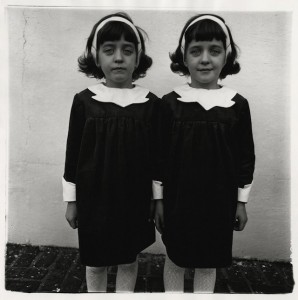Twins are fascinating. Identical twins embody the visual doubling of a single human, which often calls to mind ideas of cloning. The psychic component of twins suggests that one can complete the other’s thoughts, that they feel the same thing and that, in effect, they are one single human being in two separate bodies. In the 1975 Disney film Escape to Witch Mountain, two orphaned twins are abducted and forced to live in a magical mansion. The two realize that through their shared psychic powers, they can make marionettes — normally mere inanimate objects, child’s toys — move and dance. Though the twins in this film are not identical or the same sex, together they conjure the eeriness of twins, especially child twins like the Gradys in the horror film The Shining (1980), which was released only a few years later. Twins occupy a significant space in the pop culture imagination — but what about in the realm of visual art?
Recently in Lake Forest, a suburb north of Chicago, two identical twins named Paul and Phil Gayter presented an exhibition called Twinism (closed March 15 at Re-Invent Gallery) in which they attempted to reflect their “uncanny twin connectedness” through the titular concept that they coined. Though the exhibition has closed, there’s a video over on Chicago Tribune that adequately displays their work. The concept of ”twinism” is quite simple, actually: One twin paints one side of a single canvas, and then covers it up, leaving the other side blank and exposed. Twin number two enters, and paints the other side without looking at what his brother made. The resulting single painting forms a sort of single thought, moment or concept that the twins unknowingly shared as they painted.
Read the full story on Hyperallergic: http://hyperallergic.com/71562/twinned-times/




